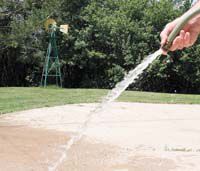| Using water to wash concrete should be eliminated during drought periods. Brooms should be used instead. |
The urge to beautify yards and landscapes tends to accompany the spring season.
But local residents should remember that Carbon County ounty is facing a drought situation and water conservation should be at the top of to do lists.
Utah is one of the five fastest growing states in the nation.
From 1990 to 2000, the statewide population increased by more than 510,000 people to top the 2.2 million mark.
According to the governor’s planning and budget office, Utah’s rapid growth will continue, with the population more than doubling to nearly 5 million by the year 2050.
As the state’s population grows, so will the demand for Utah’s limited water resources.
If Utah’s municipal and industrial water demand increase at the same rate as the population growth, the state is headed for trouble, according to the governor’s office
Utahns currently use more water then they need, especially on landscapes.
Therefore, the opportunity exists to avoid many drought related problems by reducing water usage to a more efficient level.
Increased efficiency will reduce demands and help water suppliers meet the increased future needs, pointed out the state agency.
Reducing demands, in turn, will delay expensive upgrades to existing water facilities. Conserving water also helps conserve energy, noted state officials.
When people use less water, less energy is required for treatment, pumping and distribution.
Tips for water conservationAccording to the Utah Division of Natural Resources local residents can use the following methods to improve their water conservation efforts. |
State officials have developed several conservation tips for local consumers to consider when watering outside.
The recommendations include:
•Visually inspecting sprinkler systems once a month during daylight hours.
•Avoid watering landscapes or gardens during the hottest hours of the day – from 10 a.m. until 6 p.m. – to minimize evaporation.
•Water your landscape in cycles by reducing the number of minutes on your timer and using multiple start times spaced one hour apart.
This allows the water to soak into the soil and avoids runoff.
•Turn your sprinkler system off during or after a rainstorm and leave it off until the plants need to be watered again.
•Consider installing an automatic rain shutoff device on your sprinkler system.
•Try to add more days between watering.
Allowing your lawn to dry out between watering creates deeper roots and allows you to water deeper and less often.
•Watch out for broken sprinklers, open hydrants, broken pipes and any other significant water losses in your community. Be sure to notify the property owner or the water district of the problem.
•Make sure the water coming out of your sprinklers is not misting and drifting away in the wind. This is usually caused by too high of pressure�if necessary, install a pressure reducer on your sprinkler line.
•Turn back your automatic timers in the spring and fall. Water only once or twice a week during the spring and fall. Once the cold weather has set in stop watering all together.
By following a few easy steps we can make a big impact on water conservation. For more information and helpful tips, you can go to the Utah Division of Natural Resources website at www.nr.utah.gov.

